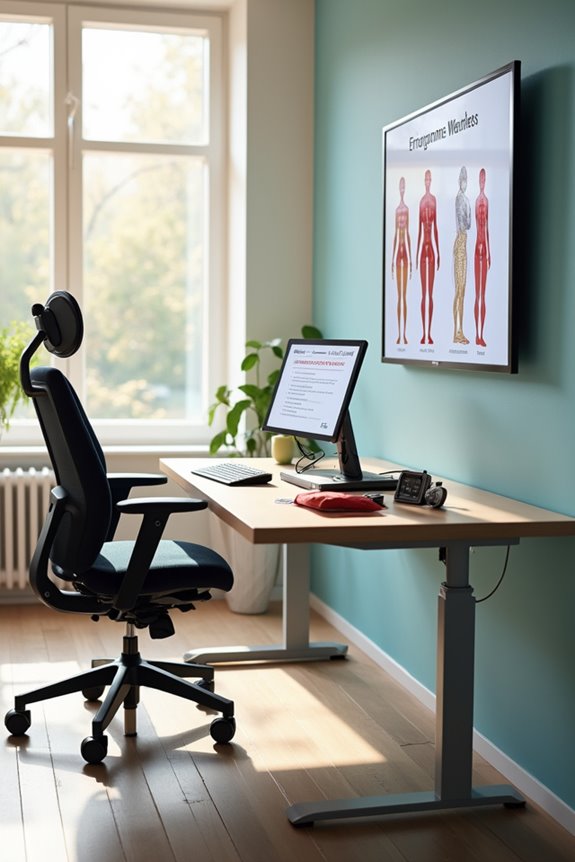Workplace wellness programs supporting chronic pain management involve several key components:
- Early Screening: Health Risk Assessments (HRAs) identify chronic pain risk factors.
- Ergonomic Solutions: Assessments optimize workstations to reduce physical strain.
- Mental Health Support: Resources include stress management and mindfulness training.
- Physical Interventions: Engagement in stretching and safe lifting techniques prevent discomfort.
These programs enhance productivity and reduce absenteeism, beneficial for both employees and employers. More information on overcoming challenges in implementation follows.
Key Takeaways
- Implement early screening and Health Risk Assessments (HRAs) to identify chronic pain risk factors and tailor interventions effectively.
- Provide ergonomic assessments and adjustments to optimize workstations, reducing strain and pain triggers for employees.
- Offer integrated wellness services, including counseling, pain management referrals, and mental health support for holistic employee care.
- Incorporate alternative modalities like massage therapy and acupuncture into wellness programs to enhance employee satisfaction and alleviate pain.
- Foster employee engagement by involving them in wellness program development and maintaining open communication for feedback and improvements.
Prevalence of Chronic Pain in the Workforce
Chronic pain is a significant public health issue affecting a substantial portion of the workforce.
- In 2023, 24.3% of U.S. adults reported experiencing chronic pain within the prior three months.
- High-impact chronic pain, which frequently limits life or work activities, affected about 8.5% of adults.
- Historical data shows variations in prevalence; for instance, in 2019, 20.4% of adults reported chronic pain, with 7.4% experiencing high-impact forms.
- Demographic disparities exist, with women and older adults reporting higher prevalence rates.
- Additionally, American Indian and Alaska Native adults exhibit the highest rates at 30.7%.
- Chronic pain is significantly more prevalent among those unemployed or living in poverty, highlighting critical workforce demographics needing attention.
Importance of Early Screening and Risk Identification

Recognizing the prevalence of chronic pain in the workforce highlights the importance of early screening and risk identification. Employers utilizing Health Risk Assessments (HRAs) can effectively implement screening tools to identify chronic pain risk factors.
Key components of early risk assessment include:
- Computer-adaptive surveys for health-related quality of life.
- Disability and functional movement assessments to quantify musculoskeletal risks.
- Biometric tests that provide thorough health profiles.
Identifying risk factors, such as prior work injuries and lifestyle patterns, enables the customization of interventions. Early screening allows for targeted ergonomic adjustments and tailored injury mitigation programs, ultimately enhancing employee well-being. By focusing on early risk identification, organizations can allocate resources effectively, reducing chronic pain incidence and promoting a healthier workforce.
Key Features of Effective Wellness Programs

Effective workplace wellness programs are essential for managing chronic pain among employees, as they incorporate a variety of strategies tailored to meet diverse needs.
Key Features:
- Integrated Services: Employee Assistance Programs (EAPs) provide counseling and referrals to pain management specialists. Access to support groups and occupational health services enhances thorough management.
- Flexible Options: Programs offering telecommuting and adjustable schedules allow employees to monitor and manage pain symptoms effectively. Onsite fitness initiatives and tailored physical activity promote movement and reduce discomfort.
- Mental Health Support: Stress management sessions and mindfulness training contribute to overall well-being, promoting a positive work environment.
- Ergonomic Adjustments: Assessments optimize workstations, reducing pain triggers and improving functionality. Incorporating targeted heat therapy can further support employees in alleviating discomfort and enhancing productivity.
Incorporating these features fosters a supportive atmosphere for employees experiencing chronic pain.
Interventions Targeting Musculoskeletal Health

Interventions targeting musculoskeletal health are essential components of workplace wellness programs, designed to minimize discomfort and enhance employee productivity.
Ergonomic Assessments
- Adjustable workstations reduce strain and support healthy posture.
- Ergonomic evaluations identify risk factors for optimization of workspaces.
- Proper design correlates with a reduction in musculoskeletal disorders (MSDs).
Movement Interventions
- Incorporating movement breaks and stretching prevents stiffness and discomfort.
- Programs like Active Workplace Solutions include group fitness classes and standing desks.
- Functional movement assessments target muscular imbalances.
Education and Training
- Workshops on safe lifting techniques empower employees to reduce injury risk.
- Continuous training promotes engagement in musculoskeletal health programs.
Addressing Mental Health and Stigma in Pain Management

Chronic pain greatly impacts workplace dynamics, necessitating a thorough approach that includes mental health considerations alongside physical health interventions. The intersection of chronic pain and mental health is significant, with 35-45% of individuals experiencing both chronic pain and depression.
Key Considerations:
- Mental health stigma often leads to skepticism regarding pain conditions, affecting employee relationships and social support.
- Approximately 1 in 6 employees face mental health issues, which can exacerbate chronic pain conditions.
- Stigma contributes to presenteeism, increasing burnout and absenteeism rates.
Strategies for Improvement:
- Leadership endorsement is essential for fostering a stigma-free environment.
- Education and training for managers on mental health and chronic pain awareness can enhance understanding and support.
Addressing these elements can improve employee well-being and workplace productivity.
Benefits of Comprehensive Wellness Programs
Holistic wellness programs offer substantial benefits for organizations seeking to enhance employee health and productivity.
Improved Health Outcomes:
- 56% reduction in employee sick days.
- 73% of participants adopt healthier lifestyle choices.
Enhanced Productivity and Engagement:
- Up to 2.5x return on investment noted.
- 31% attribute improved focus to wellness initiatives.
Cost Savings:
- Significant reductions in healthcare utilization, including fewer hospital visits.
- J&J reported $250 million savings over a decade.
Supporting Chronic Pain Management:
- Multimodal approaches, including physical fitness and stress management, mitigate chronic pain.
- Personalized coaching and health assessments lead to tailored interventions, improving work life balance and fostering employee engagement.
These outcomes create a more supportive workplace culture, essential for those managing chronic pain.
Challenges in Implementing Chronic Pain Support
Implementing effective support for employees dealing with chronic pain presents numerous challenges for organizations.
Communication Barriers
Gaps between healthcare providers and employers hinder collaboration, impacting tailored pain management. Fragmented efforts result from poor communication, leading to unclear responsibilities for return-to-work assistance.
Coordination Challenges
Return-to-work processes lack organization, often excluding employee involvement. This misalignment delays reintegration, exacerbating chronic pain-related absences.
Employer Engagement
Employers may lack incentives to coordinate support, resulting in operational strains. Increased absenteeism leads to higher workloads for remaining staff, increasing stress and potential burnout.
Stigma Reduction
Invisible chronic pain fosters misunderstanding, preventing employees from seeking necessary accommodations. Lack of management awareness further complicates empathetic responses, isolating affected individuals.
Feedback Mechanisms
Absence of feedback loops limits program adjustments, impeding continuous improvement in chronic pain support initiatives.
Strategies for Enhancing Chronic Pain Management in the Workplace
Enhancing chronic pain management in the workplace requires a multifaceted approach that prioritizes both employee wellbeing and organizational efficiency.
Movement Strategies
- Physical therapy offers tailored movement exercises, reducing chronic pain intensity and frequency.
- Psychologically informed therapy can alleviate fear-avoidance behaviors that exacerbate pain.
Ergonomic Solutions
- Ergonomic assessments evaluate job demands and physical capabilities, creating a better fit between workers and their environments.
- Targeted adjustments from ergonomic evaluations prevent improper movement patterns and reduce pain triggers.
Alternative Modalities
– Employers should promote non-opioid treatments, such as massage therapy and acupuncture, to enhance employee wellbeing. Incorporating back massagers with heat into wellness programs can provide employees with accessible pain relief options.
Prevention Focus
– Preventive measures, including safety training and stretching programs, can address injury risks before they develop into chronic conditions.
Frequently Asked Questions
How Can Employers Create a Supportive Environment for Chronic Pain Sufferers?
“An ounce of prevention is worth a pound of cure.” To foster a supportive environment, employers should implement flexible scheduling and ergonomic adjustments, promoting understanding and acceptance among employees, thereby enhancing overall workplace well-being and inclusion.
What Role Do Employees Play in Their Chronic Pain Management?
Employees play an essential role in chronic pain management by employing self-advocacy strategies and pain management techniques. Their proactive engagement fosters a supportive workplace culture, enhancing communication, collaboration, and overall well-being among peers facing similar challenges.
Are There Specific Training Programs for Managers on Chronic Pain Awareness?
Manager training programs focusing on chronic pain awareness equip leaders with skills to support employees effectively. By enhancing empathy, communication, and policy implementation, these initiatives foster inclusive workplaces that promote understanding and well-being for those managing chronic conditions.
How Can Technology Assist in Chronic Pain Management at Work?
Technology enhances chronic pain management at work through telehealth consultations and wearable devices, enabling real-time symptom tracking. These innovations promote community support, empower individuals, and foster a sense of belonging while addressing pain effectively and compassionately.
What Legal Protections Exist for Employees With Chronic Pain?
Legal protections for employees with chronic pain encompass disability rights, ensuring workplace accommodations like flexible schedules and modified duties. Such measures foster inclusivity, supporting individuals’ health while promoting a culture of belonging and understanding within the workplace.




